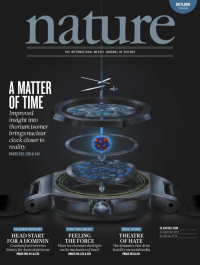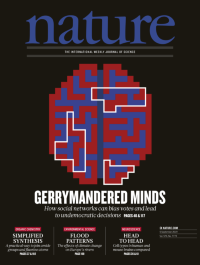Volume 573
-
No. 7775 26 September 2019
Brain tumours take rootBrain tumours are among the most lethal cancers. Primary brain tumours called malignant gliomas and brain metastases from other organs are particularly intractable. Three papers in this week’s issue probe the nature of brain tumour growth, shedding light on how the cancerous cells hijack and integrate into the brain’s neural network. Michelle Monje and her colleagues, and Frank Winkler and his team each find that cancerous glioma cells form functional synapses with neurons. Douglas Hanahan and his co-workers demonstrate that breast cancer cells metastatic to the brain participate in synaptic structures as a perisynaptic partner. The cancerous cells then use these synapses to promote their growth — the researchers find that activation of the synapses is associated with cancer colonization of the brain, malignant cell proliferation and tumour growth, emphasizing the role played by neuronal activity in brain cancer.
Nature Outlook
-
No. 7774 19 September 2019
Time to actClimate change is arguably the scientific and societal issue of our age. Unless drastic action is taken, Earth is likely to exceed 3 °C of warming by the end of the century, bringing with it unprecedented weather extremes, rising seas, mass extinctions and human misery. The science and the threat are clear − but the world and its leaders are proving slow to respond. This week, Nature is joining with more than 220 media outlets worldwide in Covering Climate Now, a coordinated initiative to raise the profile of climate coverage in the run up to the UN climate summit in New York on 23 September. With a growing youth climate movement calling for climate strikes, the energy and intensity of the debate is ramping up. Human ingenuity is up to the challenge — but only if societies, industries and governments resolve to act, and act now.
Nature Outlook
-
No. 7773 12 September 2019
A matter of timeThe current standard for timekeeping is the atomic clock, which measures time based on transitions between two states of an atom. In this week’s issue, two papers edge closer to the realization of the first nuclear clock — one that would be based on transitions between states in a nucleus and so would compete with atomic timekeepers. The nucleus in question is that of thorium-229. This is the only nucleus known to have a first excited state (229mTh) in the energy range of a few electronvolts, which makes it the lowest of all known nucleii and, crucially, accessible by lasers. But thorium poses challenges, including the accurate determination of its excitation energy and the direct optical excitation of 229mTh. In one paper, Benedict Seiferle and his colleagues present the direct measurement of the transition energy from the ground state to the first excited state. And in a second paper, Noboru Sasao and his colleagues report the direct X-ray excitation of thorium-229 to the second excited state, which then quickly decays to 229mTh.
Nature Outlook
-
No. 7772 5 September 2019
Gerrymandered mindsInformation gerrymandering can change the way we think about political decisions, as depicted in the cover image. People must integrate disparate sources of information when deciding how to vote. But information does not always flow freely — it can be constrained by social networks and distorted by zealots and automated bots. In this week’s issue, Alexander Stewart and his colleagues describe a voting game to probe the relationship between information flow and collective decision-making. In the game, players were assigned to competing parties and placed on a social network that determined whose voting intentions they could observe. The researchers showed that certain network structures can sway the vote outcome towards one party, even when both parties have equal size and each player has the same influence — a phenomenon they call ‘information gerrymandering’. A small number of zealots, when strategically placed on the network, can also induce information gerrymandering. Using real-world examples, the team demonstrates that collective decision-making is vulnerable to systematic distortion by information gerrymandering and automated zealot bots.




